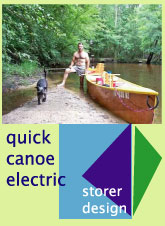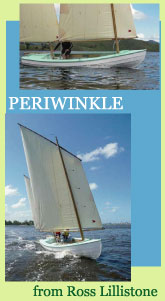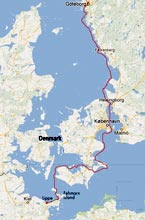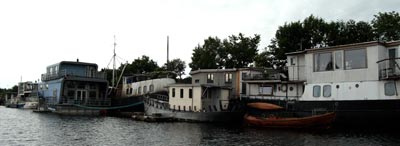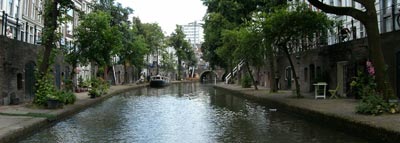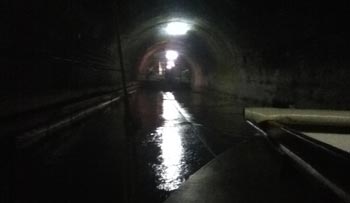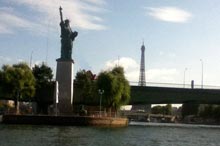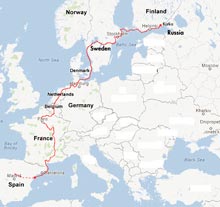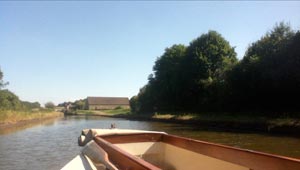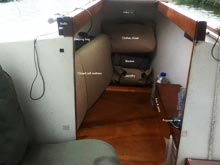
 Custom Search
|
| sails |
| plans |
| epoxy |
| rope/line |
| hardware |
| canoe/kayak |
| sailmaking |
| materials |
| models |
| media |
| tools |
| gear |
| join |
| home |
| indexes |
| classifieds |
| calendar |
| archives |
| about |
| links |
| Join Duckworks Get free newsletter CLICK HERE |
|
|
| So, Where's the Boat Now? |
by Rene Vidmer - Nazareth, Pennsylvania - USA |
| Part One - Part Two K. O. T. W. s European Odyssey - Part 2Tuesday, June 26, Faxe Ladeplads, Denmark At 9:30 in the morning, I’m contemplating a big jump South to the German border as the rains have finally stopped and the winds appear to be abating.
Thursday, June 28, Fehmarn Island, Denmark
Saturday June 30, Lippe, Germany Thunderstorms this morning. Some directly overhead. A lot of rain and noise but it cleared by noon. Am at an outdoor trestle table in Lippe harbor having a beer on this desolate coast. Sky has clouded over again but had an easy run across a 10 mile bay. There are often one or two boats to be seen on the horizon which is always comforting when sailing out of sight of land. Interestingly no one, not even the powerful sport fishermen travel at more than moderate speed. Lippe is a tiny pocket harbor and the only one for many many miles so it is full of boats. There is no anchorage so I think I’ll have to tie up here. Monday July2 2:00pm, Bad Bederkesa, Germany There is a 14 foot tide here and at near dead low and with mud flats all around I man-aged a near sleepless night, with thunderstorms and heavy rain. With the wind howling at 6:00 in the morning, I tried for a lea shore on the other side of the mile wide Elbe, and a chance of relief at the Kanal entrance. The boat did not break and we made it and here I am on a partly sunny day at an outdoor table with my hotdog and French fries.
July 11, Sneek, The Netherlands
Tuesday July 17, Teraliene, Belgium I am waiting for the sluis (bridge) to open. Actually, I’m waiting for the sluis Meister to acknowledge my presence. Later: After nothing happening for two hours I called the phone number listed by the bridge and the lock master said “ oh, I was waiting for you but you didn’t show, so I went home”. This happens sometimes because they see the little boat but ignore it. I am on the river Dender which runs South in a serpentine path from near Antwerp. It is a small but very complex river with a changing landscape around every bend, and dotted with small Belgian villages. July 21, Saturday 10am The tunnel at Bellicourt on the St. Quentin Canal
The tunnel is about 3 miles long and to traverse it you have to hook up to an electric tow boat that pulls you and a caravan of boats through the tunnel. However, I’m the only one here when the tow shows up so it’s this big tow boat with its huge hawser towing just me along. The tunnel is not very big but plenty big enough for KOTWolf and it’s fairly well lit though there’s nothing to see. Wednesday July 25, Conflans, France Two AAAA days in a row. The first on this trip of 2 months so far. Blue Sky =A. Flat water =A. Light wind =A. Temp in high 70s =A
September 4th, 2012
K. O. T. Wolf entered the Mediterranean at Sete and ran the East coast of France and Spain down to Tarragona, where she was hauled and carted to family property in Northern Spain to be patched up, refitted, and hopefully relaunched soon.
Postscript For 3.5 months I slept every night in the boats’ cabin. This was no hardship as my closed cell mattress is as comfortable as any bed. Also, I always anchored out, or tied off to an overhanging tree branch, gaining privacy and saving marina docking fees which can be considerable. Spain’s Costa Brava has plenty of harbors but almost no anchorages, and those are just open roadsteads, so I did tie up one night at a marina slip. It was a weekend, and there were parties in progress at every other slip. The din finally died down about two in the morning, but I was reminded once again why I hate docking at marinas. The first half of this journey was against the prevailing winds which are almost exclusively out of the West. Punching into these is slow going and often wet and very cold. Finland offers some interesting cruising among its thousands of small islands, but I recommend West to East. The same holds true for Sweden, Denmark, and Germany.
Although this little skiff never leaked a drop over several years of battering about the waters of the U. S. and Europe, her 1/4” plywood hull is upon examination heavily scarred, cracked, and gashed. She suffers a particularly bad foot-and-a-half-long slash in the bows, luckily well above the waterline. All of these were preventable, and most were due to inattention or failure to put out adequate bumpers in locks and docks. Nevertheless, I think the hull sides are the AF4b’s most vulnerable area. A layer of cloth and glass might not add too much weight. If you would like to contact Rene to discuss his trip or ask a question, you can email him directly at: rene@renevidmer.com |
|
